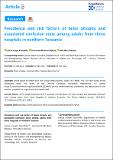| dc.description.abstract | Introduction: brain atrophy is the reduction of brain volume often accompanied with cognitive changes.Despite the availability of computerized- tomography (CT) scanners in Tanzania, little is known about the magnitude of brain atrophy, its associated on fusion state and the risk factors in adults. This study aimed to fill those knowledge gaps. Methods: a retrospective cross-sectional
hospital-based survey was conducted in northern Tanzania using a sample size of 384 CT images of adults who underwent brain CT scans in three referral hospitals. CT images were evaluated using a diagonal brain fraction (DBF) method to determine the presence of brain atrophy. Data for other covariates were also collected. Results: we report a prevalence of 60.67% for brain atrophy and 35% for the associated confusion state. Association between confusion state and brain atrophy was statistically significant (χ² = 21.954, p<0.001). Brain atrophy was prognosticated by: age (adjusted OR: 1.11; 95% CI [1.05, 1.20], p<0.001), smoking (adjusted OR: 6.97; 95% CI [2.12, 26.19], p<0.001), alcohol-consumption (adjusted OR: 11.87; 95% CI[3.44, 40.81], p<0.001), hypertension (adjusted OR: 61.21; 95 CI [15.20, 349.43], p<0.001), type-2 diabetes mellitus (adjusted OR: 15.67; 95% CI [5.32, 52.77], p<0.001) and white matter demyelination (adjusted OR: 13.45; 95% CI [4.66, 44.25], p<0.001).
Conclusion: there is high prevalence of brain atrophy and associated confusion state among hospitalized adults in northern Tanzania. Reported prognostic factors for brain atrophy such as age, smoking, alcohol consumption, hypertension, type-
2 diabetes mellitus and white matter demyelination could help focus interventions in this area. | en_US |

